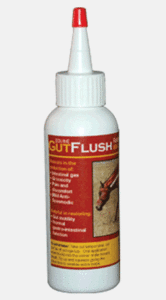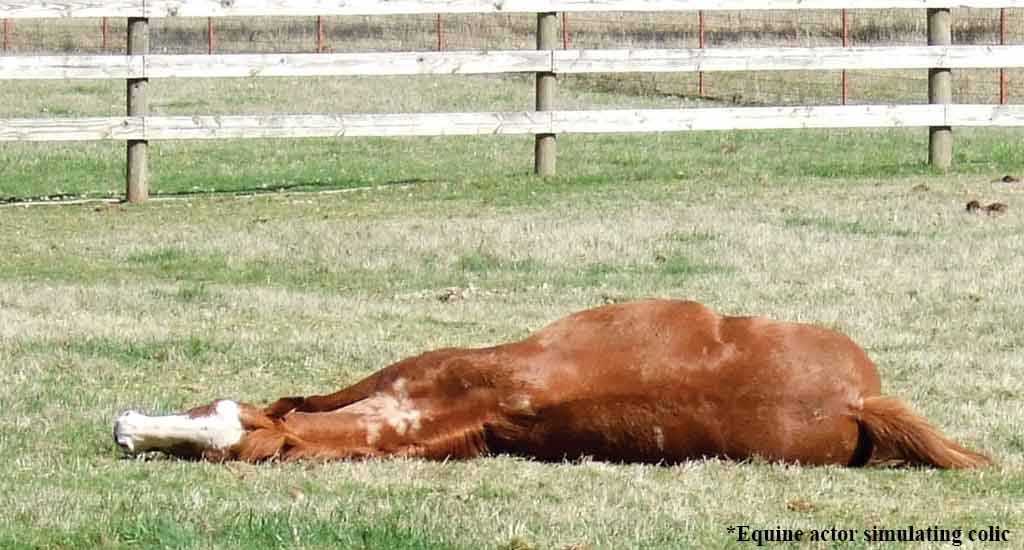Colic Solutions: Microcurrent or Colic Remedies
The knowledge of Equine GutFlush and microcurrent therapy can help your horse safely recover from colic.
Update in May 2015: This article was updated to reflect the current recommended colic remedy, which is Equine GutFlush.
Colic can strike at any time from a wide variety of causes, but one thing is the same – horse owners around the world will try nearly anything to help their horse. When your horse is suffering from colic, even old wives tales can seem like solutions worth trying. Luckily, there are some safe, affordable options that can alleviate your horse’s discomfort and help stop the bout of colic.
Even if you’ve never had a horse colic, it is likely you will run into it in the future. Be prepared. Being able to recognize colic symptoms and react quickly with effective methods can save your horse from a colic emergency.
At the first signs of colic, I recommend giving your horse Equine GutFlush (EGF). I was originally skeptical of the claims made about this product, but it is significantly cheaper than a veterinarian visit and I thought it was worth a try. After seeing EGF quickly stop colic in its tracks, I now keep it available wherever my horse goes. EquineGutFlush is an all-natural product designed to work with your horse’s body to help resolve a normal case of colic. Even if you’re at a competition that tests for drugs, EGF is safe to administer because it does not contain any ingredients that are not allowed.
 One bottle of EGF is the entire dose and the bottle comes with a plastic syringe, which makes it easy to give to your horse. After a good shake, fill the syringe and give it to your horse in the same method as paste de-wormer. According to user testimonies, horses show signs of improvement and relief from colic symptoms within 10 to 30 minutes after receiving EGF. Usually, after around 45 minutes the bout of colic has been completely resolved.
One bottle of EGF is the entire dose and the bottle comes with a plastic syringe, which makes it easy to give to your horse. After a good shake, fill the syringe and give it to your horse in the same method as paste de-wormer. According to user testimonies, horses show signs of improvement and relief from colic symptoms within 10 to 30 minutes after receiving EGF. Usually, after around 45 minutes the bout of colic has been completely resolved.
Along with EGF, microcurrent treatments are a great way to help your horse be more comfortable and recover from the case of colic. Adding a colic-specific microcurrent treatment will provide pain relief and can help relax your horse’s intestines, which theoretically can help prevent a twist from occurring. The low-level electrical stimulation from a microcurrent treatment can also stimulate impactions to pass. If your horse’s colic is impaction based, then this can resolve the bout.
Microcurrent Colic Setup
Not every type of microcurrent unit is ideal for treating colic, and the two best options are the Micro 400 or the Best-Vet device. Along with necessary outputs, these mini-sized microcurrent units are more convenient than the traditional boxed-sized units because you can attach them to your horse and continue walking it during the treatment. Signs your horse is recovering from colic are when manure has passed, respiration has returned to normal, no heave lines are present, bowel sounds have returned, and your horse wants to drink water.
Originally, the microcurrent Colic Setup was my go-to treatment for stopping colic. With the addition of Equine GutFlush to my toolbox, EGF is now my first line of defense against colic because it is extremely fast acting and easy to use. However, both options are safe and effective methods to help stop equine colic. If you are trained in the use of microcurrent and your horse is experiencing a severe case of colic, then I would recommend administering EGF then adding the Microcurrent Colic Setup to start pain relief and relaxation.
As effective as EGF and microcurrent can be, there are some causes of colic that need veterinarian attention. For instance, if a horse has already twisted its intestines or has a condition such as ruptured bowels or an ulcer it will need medical help. Therefore it is important to call your vet and keep them informed of your horse’s progress in case it is necessary for them to become involved.
Microcurrent Supplies for Colic Setup
In order to treat your horse with microcurrent using the Colic Setup there are several supplies you need to have on hand. A microcurrent colic kit includes:
- An appropriate microcurrent unit: Any of the Best-Vet devices
- 4-pack of 3-inch round pad electrodes,
- Conductive gel
- A 6-foot splitter wire
- The Colic Setup protocols and treatment steps are in the book, MicroCurrent for Horses.
Traditional Options: Addressing NSAIDs and Oil
When a horse is colicking, people commonly use flunixin meglumine (Banamine®) to help stop the colic bout. Flunixin meglumine is an NSAID (nonsteroidal anti-inflammatory), pain reliever, and fever reducer but does not address the actual issues within a horse that have caused the colic to occur. If you have no other options available, administering Banamine can help your horse become more comfortable but it is important to use Banamine responsibly. Inadvertent overdosing of Banamine or administering it to a dehydrated horse can cause irreversible kidney damage. Also, because Banamine is a pain reliever it can potentially mask the severity of a horse’s condition.
Nasogastric intubation is a common procedure performed by veterinarians for addressing colic. The problem is that if your horse has a severe impaction, adding large amounts of fluid into the mix can actually increase blockage. Using Equine GutFlushand/or microcurrent first has been successful in getting the impaction to pass, so it is worth trying them prior to nasogastric intubation or Banamine.
Colic is one of the top three causes of death in horses – along with old age and injury – but with microcurrent and Equine GutFlush you can be prepared to stop normal colic cases.
You can order a Microcurrent kit for the supplies needed for the Colic Setup and purchase the book MicroCurrent for Horses and Other Vital Therapies You Should Know by Deborah Powell for the protocols and treatment steps.
Get Started Today
Check out the Products page to find the right option to add to your therapy toolbox

